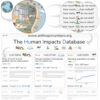A new study from a Florida State University team estimates that sugarcane fires in South Florida emit harmful particulate matter in quantities comparable to motor vehicles and is a factor in mortality rates across the region.
Their work is published in Environmental Health Perspectives.
“Over the years, there have been numerous complaints from citizens that live within and next to these fields about frequent ashfall, poor air quality, and negative health consequences from the smoke,” said Holly Nowell, an FSU postdoctoral researcher in the Department of Earth, Ocean and Atmospheric Science and the study’s lead author. “While previous studies have shown the fires have a negative impact on air quality, none have quantified mortality impacts.”
Nowell and her colleagues estimate that across South Florida, one to six deaths per year are associated with exposure to fine particles in sugarcane smoke.
Across Florida, more than 2 million acres are burned each year through prescribed burns. Most of that is to mitigate wildfire risk and maintain habitats for certain species. However, about 400,000 acres of sugarcane fields also are burned before harvest to remove non-sugar vegetation on the sugarcane stalk.
Most of the sugarcane burning in Florida is clustered around the south shore of Lake Okeechobee in the cities of Belle Glade, Clewiston and Pahokee. Sugar farming is a major economic driver for the area, employing more than 14,000 people and generating about $800 million in revenue annually.
Burning this vegetation produces smoke with unhealthful particles that are less than 2.5 microns in diameter and can be inhaled deep into the lungs. Previous studies have shown that these particles are associated with health problems such as asthma, lung cancer and cardiovascular issues.
The team found mortality rates from this exposure almost 10 times higher for residents living next to the fields as opposed to outside of the immediate area.
The research team used measurements from multiple sources including satellite sensors, ground-based monitoring and a 3D computer model of smoke dispersion to estimate burning-related exposures. They also created estimates of daily sugarcane fire emissions based on burn permits issued by the state of Florida and examined demographic and health impact data to look at causes of mortality.
They found that sugarcane fires resulted in 5,100 metric tons of these small 2.5-micron particles annually. In comparison, Florida’s on-road motor vehicles emit about 6,100 metric tons of these particles.
Researchers pointed out that though these numbers are concerning, the air quality in the region does comply with current U.S. air quality standards as do the particle pollution totals.
“We began this work because we wanted to better understand the public issues and controversy surrounding sugarcane fires and smoke in Florida,” said Associate Professor of Earth, Ocean and Atmospheric Science Christopher Holmes. “On the one hand, some residents in the sugarcane region around Lake Okeechobee are concerned about asthma and respiratory health from the sugarcane smoke. On the other hand, the sugarcane industry and its advocates have pointed to measurements showing that the average air particle pollution is within federal guidelines.”
Holmes and Nowell said this research was a stepping stone to a larger conversation about health and air quality impacts of sugarcane burning and that they hope their work will simply be used as environmental agencies and lawmakers continue to examine the practice and create guidelines for burning.
“Whether or not burning of sugarcane should continue is a hotly debated topic with people on both sides,” Nowell said. “We want growers, the public and government to make decisions using the best information about the effects of burning.”
More information:
Holly K. Nowell et al, Impacts of Sugarcane Fires on Air Quality and Public Health in South Florida, Environmental Health Perspectives (2022). DOI: 10.1289/EHP9957
Provided by
Florida State University
Citation:
Researchers find link between health outcomes and sugarcane smoke exposure (2022, August 31)



